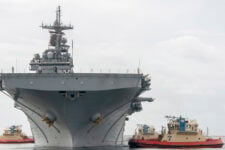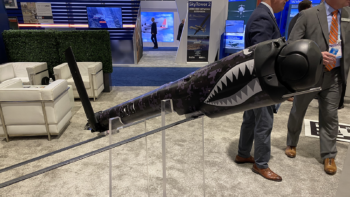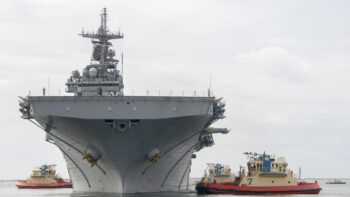
Acting Navy Secretary Thomas Modly at the unveiling of the new Ford-class aircraft carrier USS Doris “Dorie” Miller (CVN 81) at Joint Base Pearl Harbor-Hickam.
PENTAGON: The Navy wants to take $40 billion off its books over the next five years by eliminating commands, slashing logistics costs, and cutting or outsourcing back-end functions. In a Feb. 18 memo, Acting Navy Secretary Thomas Modly said the “Stem-to-Stern” review will scour the entire department for savings to find accounts that “squeeze out funds we need to build a larger fleet.”
The review comes a week after the release of the controversial fiscal 2021 budget, which includes plans to slash $4 billion from the Navy’s shipbuilding budget and $3 billion from its top line, compared to last year. The reductions are seen as part of a necessary culling of older ships and programs to pump money into an ambitious plan to build a 355-ship Navy by 2030, even as Navy budgets project little to no growth in the coming years.
But the proposals are just that. One influential member of Congress has already called the budget plan “dead on arrival.”
In the memo, Modly says “bottom line is that we need to find at least $40 billion in real line-of-accounting savings to fund the development, construction, and sustainment of this new [355-ship fleet] over the next 5 years.”
The attempt to grow the fleet, while at the same time building a new class of Columbia nuclear submarines, a new class of frigates, and new starts in hypersonic weapons and unmanned ships, is happening “within a flat budget environment we expect to continue to several years. Therefore, we must act now to make tough, fiscally-informed choices in order to fund our key strategic priorities using the budget we have, not the budget we wish we had,” the memo says.
The review is nestled within a larger Pentagon effort, spearheaded by Defense Secretary Mark Esper, to take a “white sheet” review of the entire military and cut costs, and commands, where possible. Earlier this month, Pentagon officials said they already found $5.7 billion to cut in a variety of back-end offices. Of course, every administration makes a show of hunting for efficiencies and unnecessary spending, but time and again few actual savings found.
The goal is to reconfigure the fleet to meet the challenges of Chinese military modernization, and its improving ability to hit targets at distance. The 2018 National Defense Strategy calls for a quick turnaround in fielding new, fast, lighter, more deadly weapons to meet the challenge.
So far there has been little public pushback against Esper’s plan. On the Navy side, the changes are being embraced by Modly, who has marked his eventful, three-month tenure by staking out a very public role in fixing problems with the Ford-class carrier, pushing the 355-ship fleet, overseeing the Navy’s soon-to-be released shipbuilding plan, and preparing to become the face of the Navy’s 2021 budget defense on Capitol Hill as he’s called to answer questions before Senate and House panels.
The budget request has already come under fire from Democrats and Republicans in Congress, and was labeled “dead on arrival” by Rep. Joe Courtney, chair of the House Armed Services seapower and projection forces sub-committee.
The Navy has insisted since 2016 that it needs at least 355 ships to do everything being asked of it. So far, the money to do so hasn’t arrived. In fact, budgets have slid backward, making President Trump’s boasts of having rebuilt the military a challenge for Pentagon leadership.
When looking at the bills the Navy will have due over the next five years, it’s clear it needs to dig deep into its pockets to find the money.
The budget released last week confirmed the first Columbia-class submarine is slated to cost $14.3 billion, making it more expensive than the first USS Gerald R. Ford aircraft carrier, which comes in at about $13 billion. The remainder of the 11 planned Columbia submarines, which will carry a majority of the country’s nuclear arsenal, will cost about $109 billion to build.
The new budget also outlines a path for how the Navy will begin buying its planned new class of frigates, with the first contract for the FFG(X) program coming in fiscal ‘21, eventually totaling 10 ships over the next five years, for about $10 billion.
The FFG(X) is supposed to be a small, multi-mission ship that packs 32 vertical launch cells and costs= about half of an Areligh Burke-class destroyer.
In order to clear the decks for those programs, the budget slams the brakes future production of 36 F/A-18E/F Super Hornets in an attempt to save up to $4.5 billion by 2025.
That money will in part be funneled into developing the Next Generation Air Dominance “and other key aviation wholeness investments,” Navy documents said. The NGAD program is an effort to eventually replace the Super Hornet.
As part of this general divestiture of older platforms to make way for new aircraft and ships, the Navy also wants to scrap four Littoral Combat Ships, despite two of them being less than a decade old.
But the path toward a new fleet, if the Navy figures out a way to pay for it, might have taken a step forward last week when Navy and Marine Corps leaders briefed Esper on their emerging new plan to build a new Navy by 2030. Modly said late last year he wanted the review to be wrapped up by January 15, but Navy and Marine leaders hadn’t finished their work by that date, and were leery of releasing anything before the 2021 budget.
Dropped in the middle of this is the lingering uncertainty over the expected nomination of Kenneth Braithwaite as the next Navy Secretary. In November, President Trump promised to nominate the retired admiral — and current ambassador to Norway — for the job. Sources said last month they expected the nomination to come in late February, after the impeachment hearings wrapped up, with some speculation the White House would wait until after Modly testified on Capitol Hill on the 2021 budget before pulling the trigger.
Defense companies keep up momentum on share repurchases, despite Navy leader’s criticism
Capital Alpha Partners found that buy back amounts at defense contractors were higher this financial quarter for all but only four others since March 2011.


























